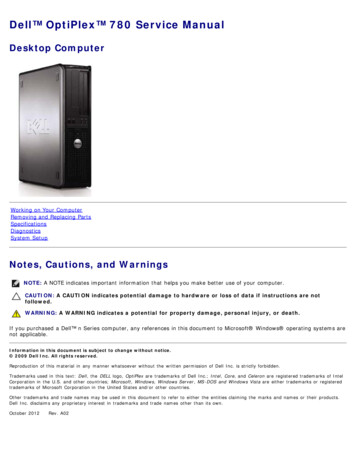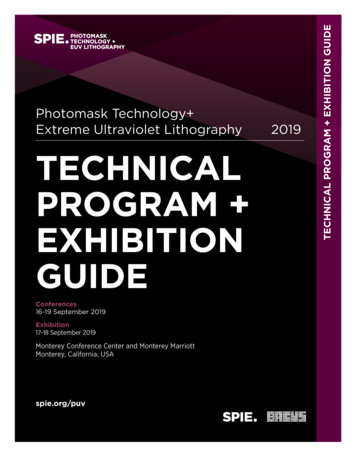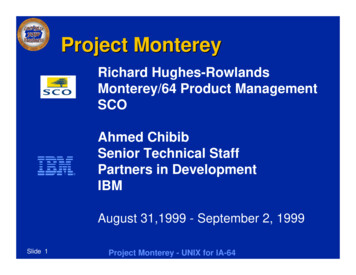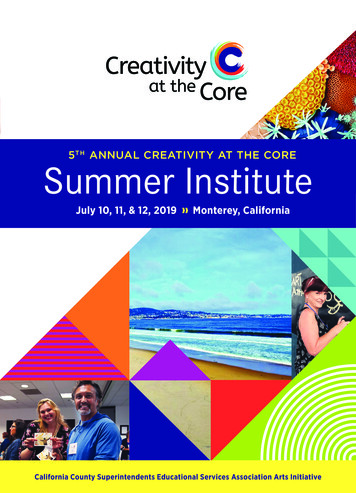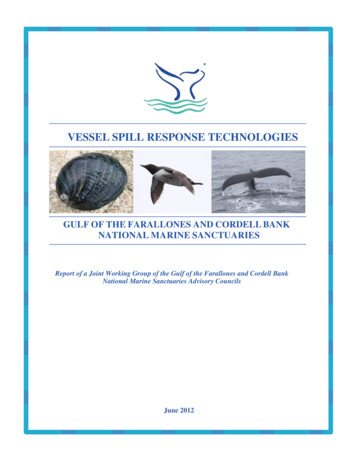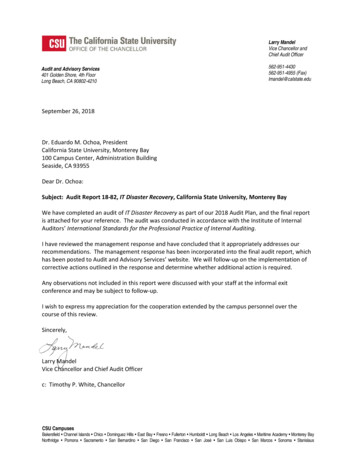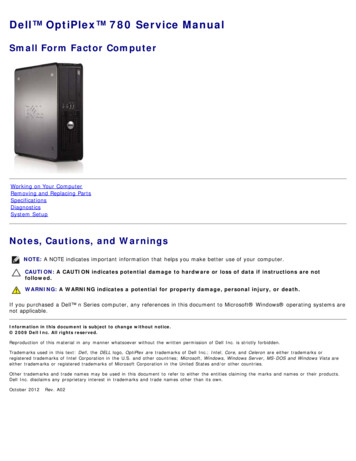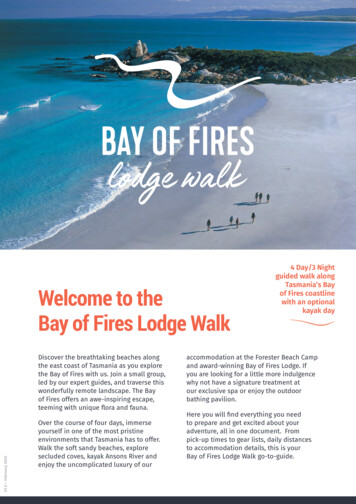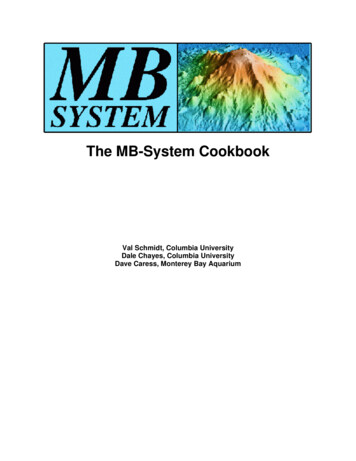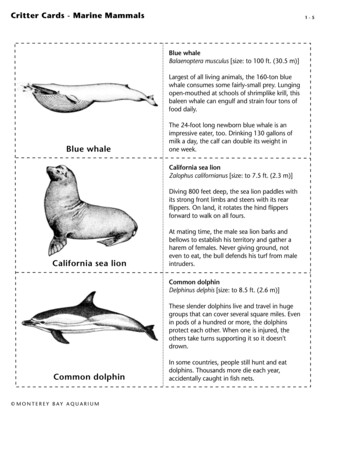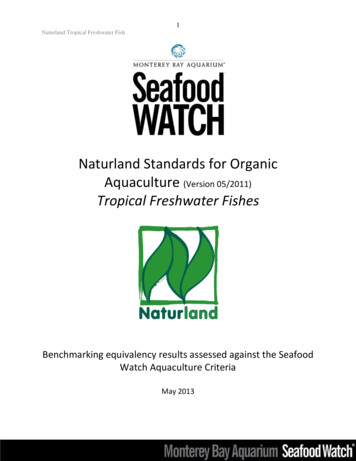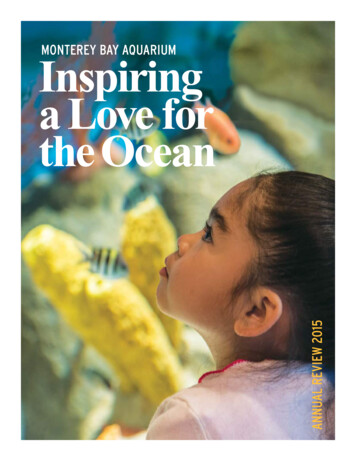
Transcription
MONTEREY BAY AQUARIUMANNUAL REVIEW 2015Inspiringa Love forthe Ocean
2015As we celebrate these accomplishments,we celebrate you for making them possible.We welcomed 2.1 million visitors—the second time thatwe’ve had back-to-back years with over 2 million guests.We hosted Big Blue Live, a live television event that celebrated Monterey Bayas an ocean conservation success story of global signifcance.Our education programs were recognized with aCommunity Impact Award from The Silicon Valley Business Journal.The White House honored our own Sarah-Mae Nelson for her workinterpreting the effects of climate change on ocean health to our visitors.We’re playing a leading role in the fght for a plastic-free ocean, andbacked state and federal actions that will phase out plastic microbeads.H u m p b a c k Wh a l eMegaptera novaeangliae
E X E C U T I V ED I R E C T O R ’ SR E P O R TJULIE PACKARDExecutive DirectorDue in great part to our amazing family of donors, the Monterey Bay Aquariumenjoys an enviable position among ocean conservation organizations. We’rethe most admired public aquarium in the United States, where we inspiremillions of people to care more—and do more—for the ocean. We’re a leader ineducation—reaching tens of thousands of students each year, bolstering the skillsthat science teachers bring to classrooms throughout California and inspiringa new generation of dynamic young ocean advocates. And we’ve grown tobecome an infuential international champion of ocean initiatives.You have helped us become moreeffective than ever before in our missionto protect and restore the ocean and theanimals that call it home.I’m so proud of what we accomplishedtogether in 2015, with your wonderfulgenerosity making possible so manyimportant successes.For the second time in our 31-yearhistory, we welcomed more than2 million visitors to the Aquarium inback-to-back years. Our visitors toldus, in greater numbers than ever, thatthey learned something new aboutocean conservation during their visit—and were inspired to take actionon behalf of the ocean.As you know so well, since ouropening we’ve shared the unique storyof Monterey Bay and its ecosystems inour exhibits. Last August, we broughtthat story to millions more across the2country and in Great Britain when wehosted an incomparable live televisionevent from our back decks: Big Blue Live.Over six nights, BBC and PBScelebrated the health of the bay’swildlife and ecosystems on prime-timetelevision—spotlighting its recoveryas a conservation success story ofglobal signifcance.The decline and rebirth of MontereyBay carries lessons that inform every-thing we do. It demonstrates that theocean is resilient, and can recover whenpeople take action to protect it. Thebay’s vitality is the product of humanactions dating back more than a century:the 1911 treaty that ended the fur tradefor sea otters and seals, creation of thefrst marine protected area off PacifcGrove in the 1930s, the ban oncommercial whaling and the explosionof environmental legislation in the 1970s,better management of commercialfsheries over the past two decadesand creation of a network of marineprotected areas along the Californiacoast less than a decade ago.There’s much more to be done,of course, both here and around theworld. Your support is enabling us tolead change on many fronts. I’m proudto say that our work is now global inscope, and in its impact on the futureof the ocean.We played a strong role in advisingthe Obama Administration on shapingregulations to end illegal, unregulatedand unreported fshing on the highseas. Our work infuenced the fnalfederal rules and subsequent legislationto keep seafood from destructivefsheries out of the U.S. market.We were part of a U.S. delegationto international scientifc advisorybodies working to reverse severepopulation declines that have reducedPacifc bluefn tuna to just 2.6 percentof their historic level. And we welcomednearly 200 experts from around theworld for the frst Bluefn FuturesSymposium to share data and ideasthat will put bluefn tuna fsheries ona sustainable trajectory.As part of our new initiative to stemthe fow of ocean plastic pollution, wechampioned the legislative campaignin California that banned plasticmicrobeads in personal care products,and subsequently supported successfulfederal legislation that will phaseout microbeads nationwide.In the face of growing threats toocean health from the impacts ofclimate change, we stepped up ourresponse. We mobilized public supportfor bold action at the COP21 climatenegotiations in Paris, and identifedthe steps needed to respond to theeffects of rising sea level on theAquarium and the communitiesof the Monterey Peninsula.We advanced initiatives to supportsustainable seafood production aroundthe world—bringing our respectedSeafood Watch program to a globalaudience. We brought business andgovernment leaders together in Southeast Asia to shape new standards forsustainable aquaculture, and welcomedIndonesia’s progressive fsheries ministerto the Aquarium in Monterey. Wehelped colleagues in Brazil, Japanand Europe advance their sustainableseafood initiatives, and worked withpartners in Mexico to move towardsustainable fshing and aquaculturein the Gulf of California.3We welcomed new business partnersin 2015, including Disney Parks andResorts, and celebrated the accomplishments of partners like Aramark, whichnow sources 100 percent of its tunafrom sustainable sources.Knowing how critical it is to fosterthe next generation of ocean leaders,we’re also deepening our investment ineducation programs. We’re committedto helping thousands of children andyoung adults become science and oceanliterate, confdent and ready to act onbehalf of the future of our planet.To that end, we completed designfor our new Center for Ocean Educationand Leadership in 2015, and expectto break ground by the end of this year.I’m grateful for the generosity that ourcommunity of donors and friends hasshown thus far and look forward toenlisting support from many moreof you so we can make this importantnew center a reality.Our vision of a future with a healthyand productive ocean that sustains alllife is within reach, and it all startswith awareness of the ocean’s value.With our status as the best place in theworld to experience and learn aboutthe ocean, the Monterey Bay Aquariumis truly driving change on a globalscale. Thank you for your confdenceand support that make it all possible.
C H A I R M A N ’ SL E T T E RFrom my earliestdays as a Trustee ofthe Monterey BayAquarium, I havebeen impressed anddeeply gratifed byhow our educationSTEPHEN C. NEALChairmanprograms are transforming and inspiring young lives. Thatpower to transform and inspire is thedriving force behind our ambitiousdecision to create a new Center forOcean Education and Leadership.Preschool children and their familiesare flled with enthusiasm when theyparticipate in our morning programsfor Head Start students. There’s equalenthusiasm in the voices of our educators—the people who can spark what wehope will become a lifelong connectionwith ocean animals.Our Discovery Lab classrooms areflled with energy every weekday asB O A R DO Fbusloads of students arrive, from all overCalifornia. Our talented teachers offerscience education lessons, completewith live-animal elements, that thosestudents carry with them when theyreturn to their classrooms. Imagine theimpact when we can offer experienceslike these to every student who visits!Out in the exhibit galleries, I’mamazed by the young men and women—Teen Conservation Leaders—who aresharing what they’ve learned with ourvisitors each day. We are buildinglong-term relationships with thesededicated young people, and they areenhancing and cementing their rolesas next-generation ocean conservationleaders. Our long-term partnershipwith Pajaro Valley schools is having afurther transformative effect on manyteens who have become the frst intheir families to attend college.Each summer, and in workshopsthroughout the school year, hundreds ofscience teachers come to the Aquariumfor professional development programs.They return home better equipped to useecosystem-based learning approaches intheir classrooms. They are deeply dedicatedto their craft and to their students.Our education programs are changinglives—and we know they will do somuch more effectively when we have thefacilities to deliver the same programsto twice as many students and teachers.I am grateful to all of you for embracingthe vision behind the Center for OceanEducation and Leadership—and foryour fnancial support that is turningthe vision into a reality.On behalf of our Board of Trustees,thank you.T R U S T E E SStephen C. Neal, ChairmanWilliam LandrethPeter S. Bing, Chairman EmeritusJoan LaneJulie Packard, Vice Chairman and Executive DirectorMichael A. MantellSusan BellConnie MartinezMeg CaldwellPietro ParravanoSamantha CampbellChristopher ScholinCaroline GettyMark WanJuan GoveaGideon YuM.R.C. Greenwood45
Big Blue Live positionedMonterey Bay as a conservationsuccess story of global signifcance.The ProgramThe ProductionThe PopularityOur back decks were the primary set forBig Blue Live was the frst co-producedAn astounding 75 million BBC and PBSthis worldwide television phenomenonjoint broadcast event for BBC andviewers watched Big Blue Live on televi-on BBC and PBS. The nine hours ofPBS—and the Monterey Bay Aquarium.sion and online. The program was alsolive programs were captivating, as theThe unprecedented live televisionhighly successful on social media. PBS,weather, animal activity and oceanseries was over a year in the making,BBC and Aquarium social media teamsanomalies combined to create a hugelyand ultimately involved about 450collaborated to produce imaginativeengaging viewer experience with rarepeople responsible for everythingand engaging animal and conservationblue whales, mysterious great whitefrom cameras to catering, boats tostories that signifcantly amplifed thesharks, sea otters and more.beach scouts and more. It’s the biggestreach of the programs—and weremedia event we’ve ever staged at theeventually seen by over 25 millionIn the end, Big Blue Live was a story ofAquarium—much larger than evenviewers. Notable content included thehope that proved ocean ecosystemsStar Trek IV. In the end, Big Blue Livebroadcasts themselves, videos aboutare resilient and can recover if given aexceeded all of our high expectationsAquarium exhibit animals and thechance—and with a helping hand fromfor this inspiring program—in content,recovery of Monterey Bay, and a seriespeople like you, who come togetheraudience size and reaction—and inof fun contests. Fans and followers wereto make a difference.sharing with the world the messageactively engaged with us and eachthat conservation works.other during the broadcasts—includingon some social media platforms at thehighest levels we’ve ever seen.BBC personalities Liz Bonnin andMatt Baker hosted Big Blue Live andwere also featured in stories aboutanimals at the Aquarium and inMonterey Bay.6Conservation scientist M. Sanjayan,on left, also hosted the Big Blue Liveseries as well as several stories aboutwildlife conservation in and aroundMonterey Bay.7The Aquarium was the main setfor Big Blue Live on BBC and PBSthat positioned Monterey Bay as aconservation success story ofglobal signifcance.
Monterey Bay Aquarium’sGlobal ImpactWith your support andencouragement, ourocean policy, conservationresearch and sustainableseafood programs aremaking a real differencefor ocean health aroundthe world. Here arehighlights of whatwe accomplishedover the last ramentoFranceMontereySan DiegoWashington, SEAN nationsSri AustraliaSouth AfricaChileNew ZealandSeafood PartnershipsOur leadership is recognized by colleaguesaround the world. In collaboration withour business partners, we’re working inSri Lanka, and with ASEAN nations inSoutheast Asia, to improve fshing andfsh-farming methods. We’re active onsix continents—in countries from SouthAfrica to Japan, Mexico and Brazil—tobuild the capacity of regional sustainableseafood movements, and to strengthen ourcollective impact by coordinating efforts.White Shark ScienceWe concluded a record feld season, taggingand tracking adult and juvenile white sharksoff the coasts of California and Mexico. Ourfeld researchers have identifed 117 individualwhite sharks, 43 new animals in 2015 andone shark that returned to the FarallonIslands for a record 27th year. Partneringwith the Monterey Bay Aquarium ResearchInstitute and others, we’re developing acamera tag that will reveal what adultsharks are doing far offshore near Hawaii,at the “White Shark Café.”8Plastic PollutionPlastics threaten the health of marine lifein the global ocean. We championed theCalifornia campaign that banned plasticmicrobeads in consumer products. Thelegislation inspired swift, bipartisanCongressional action on a national ban.And we forged a network of leading U.S.aquariums that will campaign to eliminateother major sources of plastic pollution.Bluefn TunaOur science and policy teams traveled toEcuador, southern California, Japan andSamoa to address the crisis facing Pacifcbluefn tuna. We welcomed experts from 14countries around the world to Monterey for afrst-ever Bluefn Futures Symposium to seekways to recover bluefn tuna in the Atlantic,Pacifc and Southern oceans. Satellite tagswe’ve deployed on Pacifc bluefn tuna haverecorded 106,937 days of data about theirmigrations. We’ve placed 1,254 tags on thesefsh, whose population has declined by97 percent since the 1980s.Engaging with BusinessSeafood Watch business partners usetheir purchasing power to transform fshingand aquaculture practices—in big ways.Aramark shifted to 100 percent sustainabletuna for the 2.5 million pounds of cannedalbacore and skipjack it serves annually.Seafood purchased for Disney Parks andResorts in the U.S. is now guided by ourSeafood Watch standards.9Policy LeadershipWe’re sought as a trusted advisor by theWhite House, federal agencies and stateleaders in California on a wide range ofissues, including reduction of ocean plasticpollution, combatting illegal and unregulatedfsheries, advancing domestic and international protections for sharks, and maximizingthe effectiveness of ocean conservationprovisions in international trade agreementsaround the Pacifc Rim.
Inspiring FutureOcean LeadersWhile we expand our conservationimpact beyond Monterey Bay, weremain dedicated to nurturingfuture ocean stewards at home.For over 30 years, our free visitsand education programs forschoolchildren have encouraged young people to embracetheir curiosity about science and the natural environment.Now we’re preparing to double the reach of our programsfor students and teachers through our new Center forOcean Education and Leadership on Cannery Row.Life-Changing ExperiencesYou make it possible for schoolchildren from all backgrounds to visit theAquarium, to learn about the marine environment and to ultimately becomeconfdent, science-literate and ready to act on behalf of the natural world.We’re proud to share just a few of the many life-changing experiences thathappen every day because of your support.Young Womenin ScienceTeen ConservationLeadersTeachers“I love the Aquarium because being“Being a conservation leader is part ofHabitats program has been the mosta scientist was just a dream, butmy identity [now]. It means going abovepersonally and professionally rewardingwith the Aquarium’s help, it’s almostand beyond to connect with the environ-endeavor of my teaching career.”within reach.”ment and, more importantly, to connect– Sage S.“If it wasn’t for Young Women in Sciencethat knowledge with others, combiningI wouldn’t have found my love of theyour knowledge and actions to helpocean, I wouldn’t be aware of ourconserve our oceans.”environment, I wouldn’t have become10– Felicia D.a Teen Conservation Leader and mostimportantly, I wouldn’t have gained theknowledge and understanding of whatimpact we have on this world.”We’ve continued our 165 million campaign, which includes 65 million for the LEED-certifed building and expandedprograms for teachers and students.the Watsonville Area Teens Conserving– Gary Martindaleothers with the environment. It meanslearning all that you can and then sharingAt a time when threats to the ocean grow more urgent eachday, this is our most important undertaking—one that willbeneft the planet for generations to come.“Being involved as a partner in building- Mariah P.“The Aquarium changed how I thought,how I felt, and what I did in my interactions with the ocean environment. I wasable to follow my curiosity while beingsurrounded by teens who not only careabout the same issues I do, but havethe desire to act on them as well.”– Katie R.11“Thanks to the Aquarium workshop, Iam better able to bring science into myclassroom. It really gave me a backboneto believe that I can do this.”– Teresa Day, Teacher Institute participantTeens ConservingHabitats“The Aquarium’s program has inspired meto be a lifelong advocate for sustainabilityand environmentalism in all aspects of life.”– Anthony B.
Va m p i r e s q u i dVa m p y r o t e u t h i s i n f e r n a l i sCock-eyed squidOpisthoteuthis sp.Histioteuthis heteropsisContinuing over 30Years of Innovation in Sharing Amazing AnimalsOur Tentacles team boosted the wow factor of the breakthrough special exhibition in 2015 when they introducedvisitors to several species of deep-sea cephalopods. We were the frst in the world to debut the mysterious vampiresquid, and among the frst to show the cock-eyed squid and the Japetella octopus. Another uncommon animal becamean international media sensation after a research colleague at the Monterey Bay Aquarium Research Institute dubbedthe as-yet-unnamed Opisthoteuthis species “adorabilis”—the “adorable” octopus. Your support is critical to our success inbringing uncommon animals like these to the public. Thank you.
ReachingVisitors &Inspiring ConservationMore than 2 million guestsenjoyed our live animalexhibits and special visitorprograms, and in the process,learned more about our vitalwork to protect ocean habitatsand wildlife. A visit to the Aquarium is our best tool forinspiring people to care more—and do more—for oceanconservation. In fact, 95% of our visitors say their visitinspired them to consider taking action on behalf ofthe ocean. Last year, we invited visitors to take a deeperlook at the conservation stories behind the animalswe exhibit and the ecosystems we interpret with newprograms, animal stories and outreach activities.Turning the TideFrequent Flyers(with Flippers)Conservation Chicksincredible rebirth of Monterey Bay.We’re one of 10 U.S. aquariums to fostertion; both hatched from eggs laid byTold on both land and sea (a frst forbaby loggerhead sea turtles rescued offexhibit birds. These fuzzy additions wereus!), “Turning the Tide: The Story ofNorth Carolina. Here, the wee turtlesamong several penguin and murre chicksMonterey Bay” wove a tale about thecharm our visitors while we share thethat have hatched here over the pastregion’s diverse cultural history. Thestory of their endangered species.few years. Some birds we keep; some weshow featured theatrical interpretationsAfter a year or two, they’ve grown largesend to other accredited institutions asof particular tools and talents eachenough to join other rescued juvenile seapart of species survival plans governedculture used to harvest the bay’sturtles that are ftted with satellite tagsby the Association of Zoos and Aquariums.living bounty.and released into the Atlantic Ocean.Saving EndangeredSpeciesBig Love forGiant Sea BassIn May, we marked Endangered SpeciesWith their hefty weight and wide, wideDay with 229 Association of Zoos andlips, the giant sea bass we exhibit hold aAquariums (AZA) colleagues acrossspecial place in the hearts of our visitors,the country with a new initiative:and especially our members and donors.AZA SAFE—Saving Animals FromWe house several of these critically endan-Extinction. We drew attention to seagered fsh, ranging from babies to adultsturtles, sharks, African penguins and30 years old. By studying individuals atother animals whose kin are strugglingdifferent life stages, we could help strengthenin the wild. And we shared positive newslaws protecting these gentle giants.A dynamic new summer deck showshared the rich fshing history andabout how we’re making a differencefor their survival.¡Viva Baja! BeginsWe prepared for our 2016 special exhibition,¡Viva Baja! Life on the Edge, which openedMarch 19. ¡Viva Baja! explores a uniqueand fragile place, where life thrives on theedge of sand and sea but whose futurehangs in a delicate balance. Exhibitsfeature a rainbow of tropical fshes andinvertebrates, plus iconic desert animals.1415We welcomed a penguin chick and acommon murre chick into our avian collec-Thank You, Volunteers!In more ways than ever, Aquariumvolunteers enhance our mission toinspire conservation of the ocean. In2015, over 1,300 volunteers contributedover 163,000 hours of service in 79different work areas, notably in educationand animal care. Our volunteer communityhails from all over central and northernCalifornia—86 cities in all—andvolunteers range in age from teenagersto folks in their 90s.
Va m p i r e s q u i dVa m p y r o t e u t h i s i n f e r n a l i sConservation Works—Bringing Sea Otters Back from the BrinkBesides Big Blue Live, we witnessed another success story—two, actually—closer to home: Wild sea otters delivered pupsin our Great Tide Pool in December and March. The most recent birth happened before our eyes—and was witnessedby a lucky crowd of guests, members, staff and volunteers who cheered (quietly) as mom deftly handled her newborn andgroomed it into a fuffy phenomenon. This adorable event was made possible by people like you supporting conservation ofthis threatened species. Not long ago, sea otters were hunted to near extinction. Thanks to legislative protection and a changeof heart toward these furriest of sea creatures, the sea otter population is rebounding to steady levels in Monterey Bay.1617
F I N A N C I A LI N F O R M A T I O NF I N A N C I A LI N F O R M A T I O NFor the year ending December 31, 2015Memberships14%SUPPORT AND REVENUES20152014Admissions. 43,131,000 40,295,000Contributions and Grants . 16,899,00035,828,000Memberships. 12,156,00011,348,000Endowment Distribution. 4,224,0003,893,000Merchandising and Food Services. 4,047,0004,199,000Fee-Based Programs. 1,885,0002,636,000Rental Facilities and Other . 2,667,0002,612,000Total Support and Revenues . 85,009,000 100,811,000Merchandisingand Food Services5%Endowment Distribution5%Contributionsand Grants20%Fee-Based Programs2%Rental Facilitiesand Other3%2015 SUPPORTAND REVENUESAdmissions51%EXPENSES—PROGRAM SERVICESMarine Life Exhibition and Care . 33,661,000 31,200,000Education and Outreach Programs. 12,545,00011,578,000Guest Services and Marketing Programs . 12,258,00012,325,000Conservation and Science Programs . 7,221,0006,423,000Merchandising and Food Services. 2,782,0002,946,000MembershipServices Development3%2%Merchandisingand Food ServicesManagement3%and General12%Guest ServicesRentaland MarketingFacilitiesPrograms2%14%EXPENSES—SUPPORT SERVICESManagement and General . 10,328,0008,074,000Rental Facilities . 1,328,0001,320,000Development. 2,972,0003,279,000Membership Services . 1,879,0001,980,000Total Expenses . 84,974,000 79,143,0002015 EXPENSESExhibits, Animal Care,Conservation, Scienceand Education Programs63%Capital expenditures during 2015 of 11 million included development of the special exhibit ¡Viva Baja! Life on the Edge,main entrance and auditorium improvements, planning and design for the new Center for Ocean Education and Leadership,new visitor programs, digital resources for Seafood Watch and expansion of animal holding and care facilities. Copies of the2015 audited fnancial statements will be available online in August 2016.AQUARIUM ATTENDANCE20152014General Admission . 1,086,0861,033,943Member Visits . 511,276523,169Community Days / Free Visits . 216,868255,115Free School Visits . 112,881107,643Group Visits. 122,993116,118Private Events . 34,43130,189Total Attendance . 2,084,5452,066,17718PrivateEvents2%Free SchoolVisits5%Group Visits6%Community Days/Free Visits10%2015 ATTENDANCEGeneralAdmission52%Member Visits25%19
F I N A N C I A LI N F O R M A T I O NA Special Thank You to OurOcean Legacy DonorsENDOWMENT FUND GROWTH, IN THOUSANDS 140,000Our trustees play a pivotal role in advancing theAquarium’s mission to inspire conservation of theocean by generously sharing their time, experienceand fnancial support. Founding trustee Jack Parkerwas no exception, and we wish to recognize hisgenerosity and dedication to the Aquarium. 120,000 100,000 80,000 60,000 40,000JACK STEELE PARKERFounding Aquarium Trustee1984 -1997 20,000 0 78,278 80,880 113,051 130,965 127,46720112012201320142015our doors in 1984. Working with teachers and schooladministrators, we play a critical role in students’learning by engaging them in science and discovery,but without free admission these visits would not bepossible. To ensure that schoolchildren in the futureenjoy the same opportunity, we established theChildren’s Education Endowment in 2011. Over timewe plan to grow this fund and secure free access forall of our visiting students.Growing our endowment is a top priority and we greatlyappreciate our donors whose gifts today and throughtheir wills and trusts are helping to build this importantfund. Their investment in the future will have a lastingsignifcance for the Aquarium and the world’s ocean.Knowing that conservation will be a never-ending task,our Board of Trustees established the Endowment Fundfor the Future of the Ocean in 1996, with a generous giftof 1 million from Jane and Marshall Steel Jr. Since thattime, many donors have contributed to our Endowmentthat provides a secure source of funding for oureducation programs, conservation and science initiativesand exhibits, every year forever.Our total endowment in 2015 was 127 million*and 4.2 million was distributed from the fund—providing valuable support for our programs to inspireconservation of the ocean and free admission forthousands of schoolchildren and their teachers.Our programs inspire students to care about and carefor the ocean and we’re proud that over 2.2 millionschoolchildren have visited the Aquarium since opening*Our total endowment includes both donor-restricted andboard-designated gifts.20Jack and Elaine Parker were closeWe deeply appreciate Jack and ElaineWe also wish to express ourfriends of the Packard family. JackParker and the following donors forgratitude to our 411 Ocean Legacywas proud to serve as our trusteetheir generous bequests received inCircle donors for their commitmentand considered the Aquarium to be2015. Their gifts will have a lastingto the Aquarium and to a brightera “world treasure.” He was thrilled tosignifcance for the Aquarium andfuture for us all.see it succeed and wanted to leave athe ocean.gift that would allow it to continue toIf you have included a gift to thegrow and thrive after his and Elaine’sJohnnie AdkissonMonterey Bay Aquarium in your willlifetimes. Through his very generousMarjorie Callowor trust, please contact Mary Mullenbequest, he created a legacy that willPhilip and Elizabeth Dietherat mmullen@mbayaq.org orinspire future generations of oceanJames Lee Hafner831-648-4913. We would like tostewards for many years to come.Sue E. Hovdathank you and welcome you intoNancy Ma
The decline and rebirth of Monterey : 2 million visitors to the Aquarium in ; that story to millions more across the : Bay carries lessons that inform every-thing we do. It demonstrates that the ocean is resilient, and can recover when people take action to protect it. The bay's vitality is the product of human actions dating back more than a .
